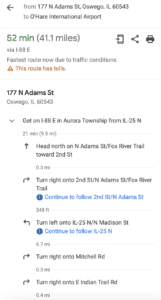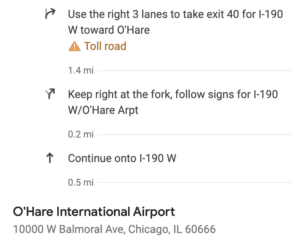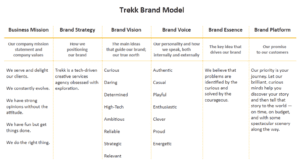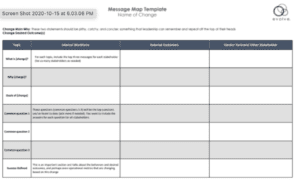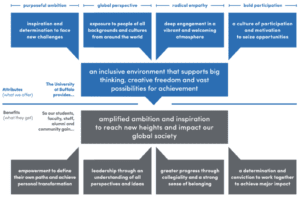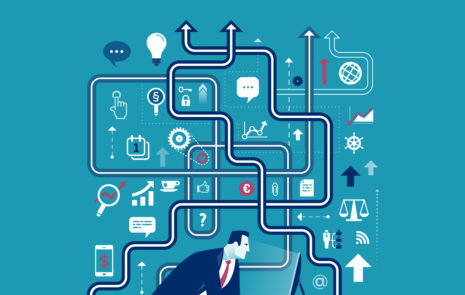
Is your marketing message easy to use?
It’s crucial to get your marketing message right
What makes a good marketing message? Your audience needs a message that’s:
- Clear, so even non-experts understand it
- Concise, to grab attention quickly
- Consistent, to build credibility over time
- Compelling, to engage people’s emotions as they decide what to do.
The right format makes your marketing message even better. Marketers need a message that’s easy to deliver in any medium – digital, physical, in-person, or hybrid.
That’s why we created Message Maps.
A Message Map helps you navigate and deliver your message
A real Message Map is visual and spatial, like a road map. At a glance, you see where to start, where you’re going and how to connect the dots to get there.
A Message Map:
- Centers on your main message, called home, which answers your audience’s first question: What’s in it for me?
- Provides people with three reasons to believe, called positive points.
- Hooks your audience in 7 seconds or 23 words.
- Scales up gracefully from 7 seconds to 2 minutes as you add proof points
- Scales up to 20 minutes as you add examples.
Here’s the anatomy of a 7-second Message Map.
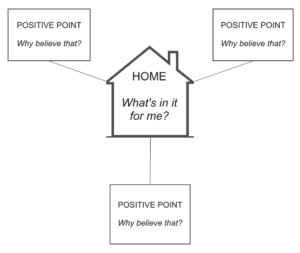
Partners, colleagues, and I have taught thousands of people to use Message Maps to get their stories heard over the past decades. A Message Map is a key part of a powerful marketing message.
Why map your message?
We intentionally format marketing messages as a map because maps:
- Are inherently visual and spatial.
- Show exactly how related ideas connect to each other.
- Enable presenters to bridge back to the main message or home while answering questions.
- Connect presenters to audiences better, since they invite you to speak in your own words rather than parrot a script or talking points.
- Enable you to maintain better eye contact with people in your audience, since you’re not reading word for word.
Over the decades, sad to say, some message map users lost their way. Some changed the map format into a spreadsheet of talking points, losing all the advantages that are inherent in a map.
Talking points may be ok for one-way communications. But when you deliver your message in an interactive forum such as a Town Hall, webinar, speech, or presentation, chances are, your audience will ask you questions. Are you ready to answer and deliver your message as you do so?
Since you always need to be prepared for two-way communications, chances are you need a Message Map. A Message Map helps you make a good marketing message.
There’s a big difference between using a map and reading directions! For example, here’s a Google map, from my house to O’Hare.

In one frame, screen or page, you see where to start, where to go, and how much progress you’ve made so far.
In contrast, here are the written directions to drive to O’Hare:
Just like talking points, detailed directions take up multiple pages. It’s a whole lot to read. And it’s not so easy to follow when you’re driving.
That’s not the way to make a marketing message good.
It’s much easier to follow a one-page map! That’s true not only when you drive, but also when you deliver your message to audiences.
Message Maps make your message easier to deliver
For example, here’s the Virgin Chicago Hotel’s 2-minute message. Its differentiating points are highlighted in yellow.
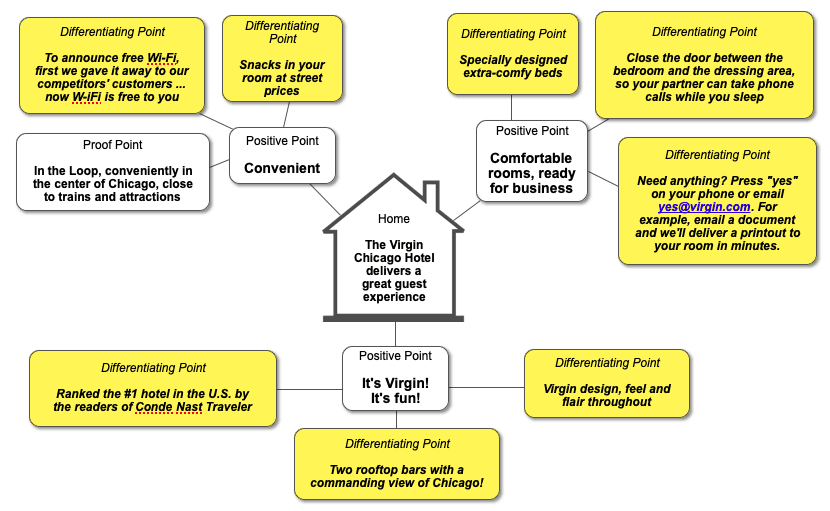
It’s super-easy to use this Message Map in interactive media, a live presentation, or a news interview. Here’s how.
First, hook your audience in 7 seconds
Share your home message and positive points first. “The Virgin Chicago Hotel delivers a great guest experience because it’s convenient, and has comfortable rooms ready for business. It’s Virgin! It’s fun!” Now, your audience knows what’s in it for them, so they’re likely to keep listening.
Your 7-second message is your elevator speech. In a presentation, next, you’ll build up your 7-second message to 2 minutes.
“The Virgin Chicago Hotel delivers a great guest experience because it’s convenient. That means it’s in the Loop, near everything downtown. It’s the first hotel to deliver free Wi-Fi in Chicago. The snacks in your room are the same price as in local stores – it’s not $5 for a bag of M&Ms.
“Virgin’s comfortable rooms are ready for business, with specially designed beds that make it easy to use your laptop or read a book in bed. Doors close off the dressing area from the bedroom so you can snooze while your partner takes a conference call. If you need anything, just press the yes button on your phone. Or send your document to yes@virgin.com and your print-out will be delivered to your room.
“It’s Virgin, it’s fun, with two rooftop bars that offer a great view of Chicago. You’ll see the Virgin design, look and feel throughout. It was ranked the #1 hotel in the US by readers of Conde Nast Traveler.”
Repeat your main message so it sinks in
Message Maps place your main message in the center, prompting you to repeat your home message as you answer questions. A home is a safe place to which you can always return.
Repeating one home message consistently is a good way to make a marketing message that sticks. Consistency leads to credibility in the eyes of your audience.
When a spokesperson gets a question about the Virgin Hotel, she can answer it and bridge all the way to the home message. For example:
“What about those comfy beds?”
“You get a good night’s sleep because our beds have a special patented design. You can comfortably work in bed, use your laptop or read a book. And you get a specially designed room that’s ready for business. That’s one of the ways you get a great guest experience at Virgin Chicago Hotel!!”
Repeat your home message 3 to 5 times
It’s crucial to repeat your home message since people need to hear it multiple times before it sinks in. People have more confidence in an idea when it’s been repeated three to five times, a study in the Journal of Personality and Social Psychology found.
In his most famous speech, Dr. Martin Luther King repeated “I have a dream” eight times. Repetition works to help your message get heard.
That’s why your home message appears in the middle. It’s the heart of your Message Map.
Use a map, not a spreadsheet, for your message
For example, how would a live speaker navigate the message below in a talk or news interview? What’s their main message? How would they connect the dots among these ideas?
How about this so-called message map? What’s the main message, the audience’s one takeaway?
Or this diagram, which bundles two sets of complex abstractions:
Make sure your Message Map works as a map!
With a real Message Map, you always:
- See what to say
- Say what you mean
- Make your message clear, concise, compelling, and consistent.
Your home message clearly tells audiences what’s in it for them. The most effective Message Maps:
- Hook your audience in 7 seconds or 23 words.
- Use concrete words that paint pictures in your audiences’ minds.
- Activate emotions rather than logic, since people make decisions emotionally.
With a real Message Map, your message becomes much easier to deliver and absorb.
Here’s more about how to put Message Maps to work for your company or brand.
Related Posts
Communicating when it’s complicated
Recently, a client said to me, “I love how you always advise clear and concise communication. It ensures our clients always understand our message....
Unlock your hidden storytelling powers
One thing in marketing never changes: with a more powerful story, you win more often. Storytelling rules. You make a clear-cut case. You gain business,...
Message Maps Outperform Outlines, Scripts and PowerPoint
On stage, one page beats other formats A 1-PageTM Message Map is a simple diagram that helps you deliver your business message even more...
Marketers: If you want to reach your buyers, you must personalize your content
In my last blog, I wrote about how talking to your customers directly about their information and research habits helps you discover the best...

